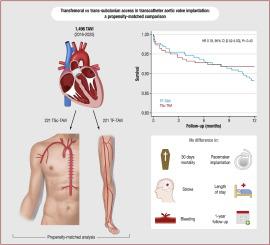Archives of Cardiovascular Diseases ( IF 3 ) Pub Date : 2023-10-20 , DOI: 10.1016/j.acvd.2023.09.006 Olivier Bennes 1 , Géraud Souteyrand 1 , Sébastien Cambier 2 , Pascal Motreff 1 , Clément Riocreux 1 , Vedat Eljezi 3 , Clément Lahaye 4 , Romain Eschalier 1 , Andréa Innorta 5 , Nicolas Combaret 1

|
Background
Transcatheter aortic valve implantation is unfeasible for 10–15% of patients using the conventional transfemoral approach. Other alternative approaches, such as the subclavian approach, have emerged, with no clear recommendation indicating the superiority of one technique over another.
Aim
To compare the 1-month mortality and postprocedural outcomes of patients undergoing transcatheter aortic valve implantation using a self-expandable valve via transfemoral and subclavian access.
Methods
This was a retrospective single-centre study including 1496 patients who underwent transcatheter aortic valve implantation between January 2016 and December 2020 at Clermont-Ferrand University Hospital, France. Propensity score matching was used to compare transfemoral and subclavian access.
Results
After building two propensity score-matched groups of 221 patients each with either access route (total n = 442), baseline characteristics were similar. The procedure duration was significantly longer in the subclavian access group (53 [45–64] versus 60 [51–72] minutes; P < 0.001), but with a lower amount of contrast agent (138 [118–165] versus 123 [105–150] mL; P < 0.001), fluoroscopy time (11.2 [9–14] versus 9.9 [7–12] minutes; P < 0.001) and radiation dose (397 [264–620] versus 321 [217–485] mGy; P < 0.001). No significant difference was observed concerning 1-month mortality (odds ratio 1.62, 95% confidence interval 0.52–5.03; P = 0.39) or periprocedural complications. Follow-up at 1 year confirmed no difference in longer-term mortality (hazard ratio 0.78, 95% confidence interval 0.52–5.03; P = 0.43).
Conclusions
The subclavian approach provides similar results to the transfemoral approach in terms of mortality, efficacy and safety; it is a reasonable and effective alternative when the reference transfemoral approach is impossible or seems complex.
中文翻译:

使用自扩张瓣膜进行经导管主动脉瓣植入时经股动脉与经锁骨下通路的比较:倾向匹配比较
背景
对于 10-15% 使用传统经股动脉入路的患者来说,经导管主动脉瓣植入是不可行的。其他替代方法,例如锁骨下入路,也已经出现,但没有明确的建议表明一种技术相对于另一种技术的优越性。
目的
比较使用自扩张瓣膜经股动脉和锁骨下通路进行经导管主动脉瓣植入的患者的 1 个月死亡率和术后结果。
方法
这是一项回顾性单中心研究,纳入了 2016 年 1 月至 2020 年 12 月期间在法国克莱蒙费朗大学医院接受经导管主动脉瓣植入术的 1496 名患者。使用倾向评分匹配来比较经股动脉和锁骨下通路。
结果
在建立两个倾向评分匹配组(每组 221 名患者,每组均采用任一接入途径)后(总n = 442),基线特征相似。锁骨下通路组的手术持续时间明显更长(53 [45–64] 分钟 vs 60 [51–72] 分钟;P < 0.001),但造影剂用量较少(138 [118–165] vs 123 [51–72] 分钟)。 105–150] mL;P < 0.001)、透视时间(11.2 [9–14] 与 9.9 [7–12] 分钟;P < 0.001)和辐射剂量(397 [264–620] 与 321 [217–485] mGy;P < 0.001)。1 个月死亡率(比值比 1.62,95% 置信区间 0.52-5.03;P = 0.39)或围手术期并发症没有观察到显着差异。1 年随访证实长期死亡率没有差异(风险比 0.78,95% 置信区间 0.52–5.03;P = 0.43)。
结论
锁骨下入路在死亡率、有效性和安全性方面与经股动脉入路提供了相似的结果;当参考经股动脉入路不可能或看起来很复杂时,它是一种合理且有效的替代方案。



























 京公网安备 11010802027423号
京公网安备 11010802027423号